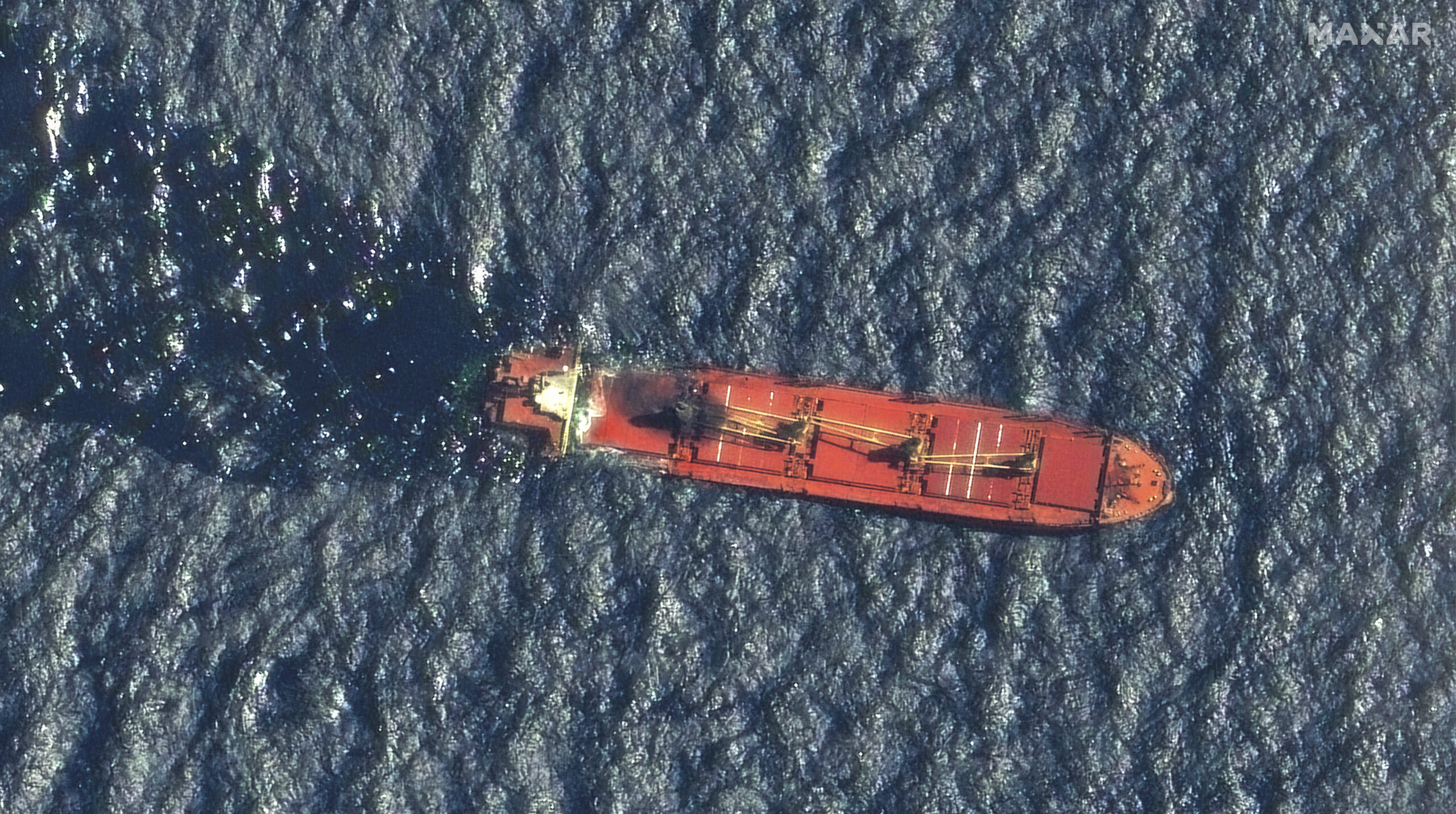

DUBAI, United Arab Emirates (AP) — A ship attacked by Yemen’s Houthi rebels has sunk in the Red Sea after days of taking on water, officials said Saturday, the first vessel to be fully destroyed as part of their campaign over Israel’s war against Hamas in the Gaza Strip.
The sinking of the Rubymar, which carried a cargo of fertilizer and previously leaked fuel, could cause ecological damage to the Red Sea and its coral reefs.
Persistent Houthi attacks have already disrupted traffic in the crucial waterway for cargo and energy shipments moving from Asia and the Middle East to Europe. Already, many ships have turned away from the route.
The sinking could see further detours and higher insurance rates put on vessels plying the waterway — potentially driving up global inflation and affecting aid shipments to the region.
The Belize-flagged Rubymar had been drifting northward after being struck by a Houthi anti-ship ballistic missile on Feb. 18 in the Bab el-Mandeb Strait, a crucial waterway linking the Red Sea and the Gulf of Aden.
Yemen’s internationally recognized government, as well as a regional military official, confirmed the ship sank. The official spoke on condition of anonymity as no authorization was given to speak to journalists about the incident.
The British military’s United Kingdom Maritime Trade Operations center, which watches over Mideast waterways, separately acknowledged the Rubymar’s sinking Saturday afternoon.
The U.S. military’s Central Command said early Sunday the Rubymar sank at 2:15 a.m. local time Saturday. It released an image of the vessel on its side as it was sinking.
“The approximately 21,000 metric tons of ammonium phosphate sulfate fertilizer that the vessel was carrying presents an environmental risk in the Red Sea,” it said in a statement. “As the ship sinks it also presents a subsurface impact risk to other ships transiting the busy shipping lanes of the waterway.”
The Rubymar’s Beirut-based manager did not respond to a request for comment.
Yemen’s exiled government, which has been backed by a Saudi-led coalition since 2015, said the Rubymar sank late Friday as stormy weather took hold over the Red Sea. The vessel had been abandoned for 12 days after the attack, though plans had been made to try and tow the ship to a safe port.
The Iran-backed Houthis had falsely claimed the ship sank almost instantly after the initial attack. Late Saturday, a Houthi leader tried to blame British Prime Minister Rishi Sunak over the Rubymar.
“You have an opportunity to salvage the ship M/V Rubymar by guaranteeing … that the relief trucks agreed upon at that time would enter Gaza,” Mohammed al-Houthi wrote in an online message.
Ahmed Awad Bin Mubarak, the prime minister of Yemen’s internationally recognized government, called the ship’s sinking “an unprecedented environmental disaster.”
“It’s a new disaster for our country and our people,” he wrote on X, formerly Twitter. “Every day, we pay for the Houthi militia’s adventures, which were not stopped at plunging Yemen into the coup disaster and war.”
Greenpeace also raised concerns about the ship sinking.
“Without immediate action, this situation could escalate into a major environmental crisis,” said Julien Jreissati, program director at Greenpeace MENA.
“As well as any further leaks of fuel oil from the engines, the sinking of the vessel could further breach the hull, allowing water to contact with the thousands of tonnes of fertilizer, which could then be released into the Red Sea and disrupt the balance of the marine ecosystems, triggering cascading effects throughout the food web.”
The Houthis have held Yemen’s capital, Sanaa, since 2014, expelling the government. The rebels have fought a Saudi-led coalition since 2015 in a stalemated war.
Satellite pictures analyzed by The Associated Press from Planet Labs PBC showed smaller boats alongside the Rubymar on Wednesday. It wasn’t immediately clear whose vessels those were. The images showed the Rubymar’s stern sinking into the Red Sea but still afloat, mirroring earlier video taken of the vessel.
The private security firm Ambrey separately reported Friday about a mysterious incident involving the Rubymar.
“A number of Yemenis were reportedly harmed during a security incident which took place” on Friday, Ambrey said. It did not elaborate on what that incident involved and no party involved in Yemen’s yearslong war claimed any new attack on the vessel.
A satellite image taken Friday from Maxar Technologies showed new blast damage on the Rubymar not previously seen, with no other vessels around it. Additional satellite images taken Saturday by Planet Labs PBC of the area the Rubymar had been in recent days no longer showed the vessel.
Since November, the rebels have repeatedly targeted ships in the Red Sea and surrounding waters over the Israel-Hamas war. Those vessels have included at least one with cargo bound for Iran, the Houthis’ main benefactor, and an aid ship later bound for Houthi-controlled territory.
Despite over a month of U.S.-led airstrikes, Houthi rebels have remained capable of launching significant attacks. That includes the attack on the Rubymar and the downing of an American drone worth tens of millions of dollars. The Houthis insist their attacks will continue until Israel stops its combat operations in the Gaza Strip, which have enraged the wider Arab world and seen the Houthis gain international recognition.
The attacks have also disrupted aid shipments to both Yemen and Sudan, which is gripped by its own monthslong war. In recent days, the International Rescue Committee said it suspended its aid shipments to Port Sudan through the Red Sea over long delays and drastically increased costs.
However, there has been a slowdown in attacks in recent days. The reason for that remains unclear. Between four to eight U.S. and allied warships now patrol the Red Sea on any given day, said Maj. Pete Nguyen, a Defense Department spokesperson.
CLICK HERE TO READ MORE FROM THE WASHINGTON EXAMINER
On Saturday, the Italian Defense Ministry said one of its vessels, the destroyer Caio Duilio, shot down a suspected Houthi drone in self-defense that appeared to be flying toward it.
“The terrorist attacks by the Houthis are a serious violation of international law and an attack on the safety of maritime traffic, on which our economy depends,” the ministry said.
___
Associated Press writer Samy Magdy in Cairo contributed to this report.






